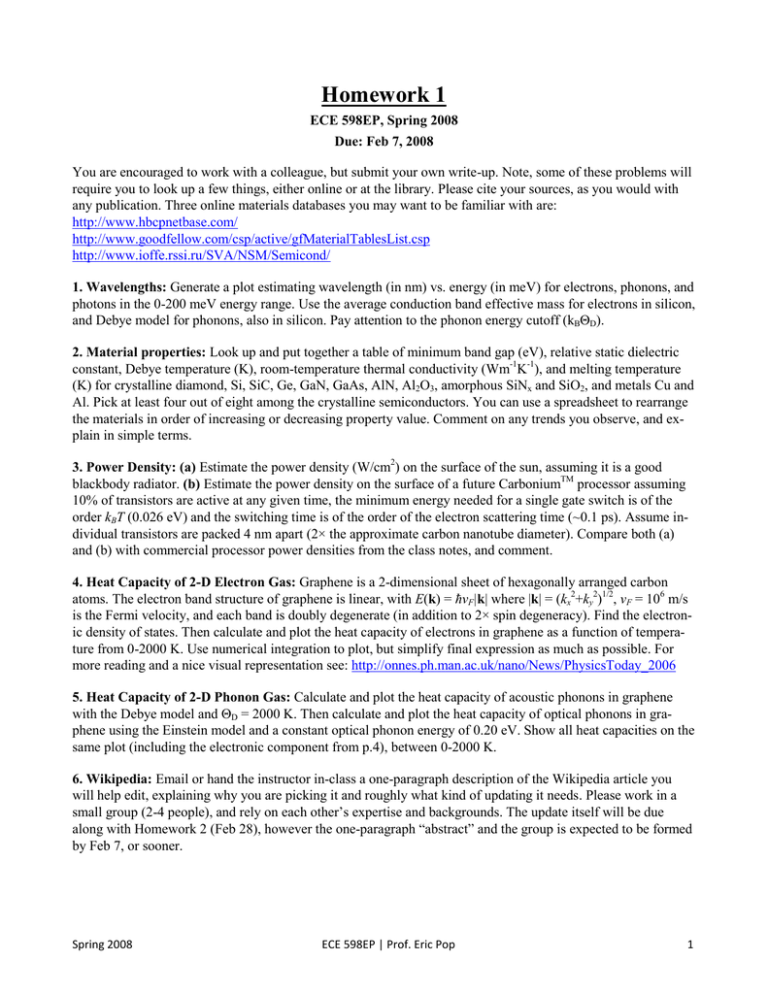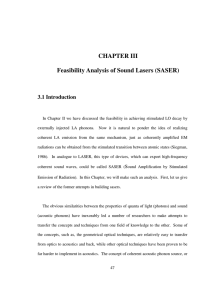Homework 1 - PopLab@Stanford
advertisement

Homework 1 ECE 598EP, Spring 2008 Due: Feb 7, 2008 You are encouraged to work with a colleague, but submit your own write-up. Note, some of these problems will require you to look up a few things, either online or at the library. Please cite your sources, as you would with any publication. Three online materials databases you may want to be familiar with are: http://www.hbcpnetbase.com/ http://www.goodfellow.com/csp/active/gfMaterialTablesList.csp http://www.ioffe.rssi.ru/SVA/NSM/Semicond/ 1. Wavelengths: Generate a plot estimating wavelength (in nm) vs. energy (in meV) for electrons, phonons, and photons in the 0-200 meV energy range. Use the average conduction band effective mass for electrons in silicon, and Debye model for phonons, also in silicon. Pay attention to the phonon energy cutoff (kBΘD). 2. Material properties: Look up and put together a table of minimum band gap (eV), relative static dielectric constant, Debye temperature (K), room-temperature thermal conductivity (Wm-1K-1), and melting temperature (K) for crystalline diamond, Si, SiC, Ge, GaN, GaAs, AlN, Al2O3, amorphous SiNx and SiO2, and metals Cu and Al. Pick at least four out of eight among the crystalline semiconductors. You can use a spreadsheet to rearrange the materials in order of increasing or decreasing property value. Comment on any trends you observe, and explain in simple terms. 3. Power Density: (a) Estimate the power density (W/cm2) on the surface of the sun, assuming it is a good blackbody radiator. (b) Estimate the power density on the surface of a future CarboniumTM processor assuming 10% of transistors are active at any given time, the minimum energy needed for a single gate switch is of the order kBT (0.026 eV) and the switching time is of the order of the electron scattering time (~0.1 ps). Assume individual transistors are packed 4 nm apart (2× the approximate carbon nanotube diameter). Compare both (a) and (b) with commercial processor power densities from the class notes, and comment. 4. Heat Capacity of 2-D Electron Gas: Graphene is a 2-dimensional sheet of hexagonally arranged carbon atoms. The electron band structure of graphene is linear, with E(k) = ħvF|k| where |k| = (kx2+ky2)1/2, vF = 106 m/s is the Fermi velocity, and each band is doubly degenerate (in addition to 2× spin degeneracy). Find the electronic density of states. Then calculate and plot the heat capacity of electrons in graphene as a function of temperature from 0-2000 K. Use numerical integration to plot, but simplify final expression as much as possible. For more reading and a nice visual representation see: http://onnes.ph.man.ac.uk/nano/News/PhysicsToday_2006 5. Heat Capacity of 2-D Phonon Gas: Calculate and plot the heat capacity of acoustic phonons in graphene with the Debye model and ΘD = 2000 K. Then calculate and plot the heat capacity of optical phonons in graphene using the Einstein model and a constant optical phonon energy of 0.20 eV. Show all heat capacities on the same plot (including the electronic component from p.4), between 0-2000 K. 6. Wikipedia: Email or hand the instructor in-class a one-paragraph description of the Wikipedia article you will help edit, explaining why you are picking it and roughly what kind of updating it needs. Please work in a small group (2-4 people), and rely on each other’s expertise and backgrounds. The update itself will be due along with Homework 2 (Feb 28), however the one-paragraph “abstract” and the group is expected to be formed by Feb 7, or sooner. Spring 2008 ECE 598EP | Prof. Eric Pop 1



